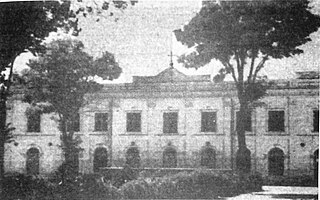This is a directory of patriarchs, archbishops, and bishops across various Christian denominations. To find an individual who was a bishop, see the most relevant article linked below or Category:Bishops.

The Armenian Apostolic Church is the national church of Armenia. Part of Oriental Orthodoxy, it is one of the most ancient Christian institutions. The Kingdom of Armenia was the first state to adopt Christianity as its official religion under the rule of King Tiridates III, of the Arsacid dynasty in the early 4th century. According to tradition, the church originated in the missions of Apostles Bartholomew and Thaddeus of Edessa in the 1st century. St. Gregory the Illuminator was the first official primate of the church. It is sometimes referred to as the Armenian Apostolic Orthodox Church, Armenian Church or Armenian Gregorian Church.

The Armenian Catholic Church is an Eastern Catholic particular churches sui iuris of the Catholic Church. It accepts the leadership of the bishop of Rome, and is therefore in full communion with the universal Catholic Church, including the Latin Church and the 22 other Eastern Catholic Churches. The Armenian Catholic Church is regulated by Eastern canon law, summed up in the Code of Canons of the Eastern Churches.
A catholicos is the head of certain churches in some Eastern Christian traditions. The title implies autocephaly and, in some cases, it is the title of the head of an autonomous church. The word comes from ancient Greek καθολικός, derived from καθ' ὅλου from κατά and ὅλος, meaning "concerning the whole, universal, general"; it originally designated a financial or civil office in the Roman Empire.
The title of patriarchs of the East is used by primates of several Christian denominations within Eastern Christianity. Historically, the title originated as ecclesiastical designation for primates of the Church of the East. It was, and still is, officially used by different branches of the historical Church of the East.

Aram I has been the head of the Catholicosate of the Great House of Cilicia since 1995 and he resides in Antelias, Lebanon.

Karekin I served as the Catholicos of the Armenian Apostolic Church between 1994 and 1999. Previously, he served as the Catholicos of Cilicia from 1983 to 1994 as Karekin II.

Armenians have lived in Lebanon for centuries. According to Minority Rights Group International, there are 156,000 Armenians in Lebanon, around 4% of the population. Prior to the Lebanese Civil War, the number was higher, but the community lost a portion of its population to emigration.
The Armenian Catholicosate of the Great House of Cilicia is an autocephalous Oriental Orthodox church. Since 1930, the Catholicosate of the Great House of Cilicia has been headquartered in Antelias, Lebanon. Aram I is the Catholicos of Cilicia since 1995.

Sahak II or Isaac II, last name Khabayan, was Catholicos of Cilicia of the Armenian Apostolic Church in 1902–1939.
Armenians in United Arab Emirates refers to ethnic Armenians living in the United Arab Emirates. They number around 5,000.

The Forty Martyrs Armenian Cathedral of Aleppo, Syria, is a 15th-century Armenian Apostolic church located in the old Christian quarter of Jdeydeh. It is significant among the Armenian churches for being one of the oldest active churches in the Armenian diaspora and the city of Aleppo. It is a three-nave basilica church with no dome. Its bell tower of 1912, is considered to be one of the unique samples of the baroque architecture in Aleppo.

Archbishop Leon Tourian was a cleric of the Armenian Apostolic Church. Appointed primate of the Eastern Diocese of the Armenian Apostolic Church of America in 1931, he was assassinated in 1933 in New York City by Armenian Revolutionary Federation members.

Holy Mother of God Cathedral, or Surp Asdvadzadzin Church, is the Armenian Apostolic cathedral of the Armenian Diocese of Cyprus, located in the Strovolos district in Nicosia, Cyprus.

Established in 1983, St. Mary Armenian Apostolic Church is at church in Toronto, Ontario, Canada in the district of North York. It belongs to the Holy See of Cilicia.
The Armenian Prelacy of Canada, is a diocese of the Armenian Apostolic Church affiliated with the Holy See of Cilicia, formed in 2002. The prelacy building is located at 3401 Oliver Asselin in Montreal, Quebec, Canada.

Christianity in Cyprus is the largest religion in the country, making up 78% of the island's population. The largest Christian denomination is the Greek Orthodox Church, while the rest are smaller communities of Anglicans, Roman Catholics, Latin Christians, Maronites, Armenian Apostolics, and Greek Evangelicals.

Armenian Diocese of Cyprus, is one of the oldest dioceses of the Armenian Apostolic Church outside the historic Armenian territories, covering the Republic of Cyprus. It has been founded during the 12th century and currently has around 3,500 followers, comprising around 95% of the Armenians in Cyprus. The diocese is under the jurisdiction of the Holy See of Cilicia of the Armenian Church.

Sepuh Sargsyan or Sebouh Sarkissian is an Armenian Apostolic clergyman. Currently he is prelate and archbishop of the Armenian Diocese of Tehran located at Saint Sarkis Cathedral, which is under the jurisdiction of the Holy See of Cilicia.

The Armenian Apostolic Diocese of Atrpatakan is Oriental Orthodox Christian diocese of the Armenian Apostolic Church in Tabriz, Azerbaijan, Iran. It is within the ecclesiastical jurisdiction of the Catholicossate of the Great House of Cilicia, seated in Antelias. The Diocese of Atrpatakan is currently headed by Archbishop Grigor Chiftchian.












